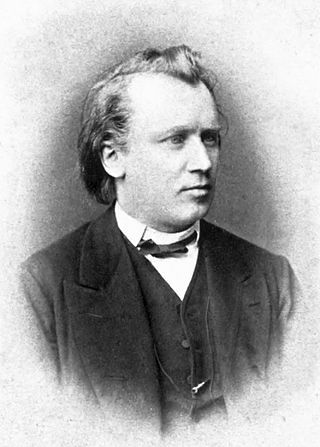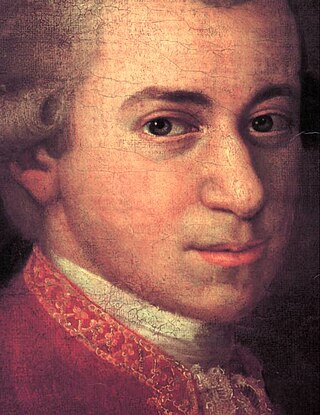The Symphony No. 6 in B minor, Op. 54 by Dmitri Shostakovich was written in 1939, and first performed in Leningrad on November 5, 1939 by the Leningrad Philharmonic Orchestra under Yevgeny Mravinsky.

Sergei Prokofiev wrote his Symphony No. 2 in D minor, Op. 40, in Paris in 1924-25, during what he called "nine months of frenzied toil". He characterized this symphony as a work of "iron and steel".
Symphony No. 6 "Sinfonia semplice", FS 116, was Danish composer Carl Nielsen's last symphony.

Symphony No. 2 in D major, Op. 73, was composed by Johannes Brahms in the summer of 1877, during a visit to Pörtschach am Wörthersee, a town in the Austrian province of Carinthia. Its composition was brief in comparison with the 21 years it took Brahms to complete his First Symphony.

The Symphony No. 1 in C minor, Op. 68, is a symphony written by Johannes Brahms. Brahms spent at least fourteen years completing this work, whose sketches date from 1854. Brahms himself declared that the symphony, from sketches to finishing touches, took 21 years, from 1855 to 1876. The premiere of this symphony, conducted by the composer's friend Felix Otto Dessoff, occurred on 4 November 1876, in Karlsruhe, then in the Grand Duchy of Baden. A typical performance lasts between 45 and 50 minutes.
Béla Bartók's Violin Concerto No. 2, Sz. 112, BB 117 was written in 1937–38. During the composer's life, it was known simply as his Violin Concerto. His other violin concerto, Violin Concerto No. 1, Sz. 36, BB 48a, was written in the years 1907–1908, but only published in 1956, after the composer's death, as "Violin Concerto No. 1, Op. posth."
The Young Person's Guide to the Orchestra, Op. 34, is a 1945 musical composition by Benjamin Britten with a subtitle Variations and Fugue on a Theme of Purcell. It was based on the second movement, "Rondeau", of the Abdelazer suite. It was originally commissioned for the British educational documentary film called Instruments of the Orchestra released on 29 November 1946, directed by Muir Mathieson and featuring the London Symphony Orchestra conducted by Malcolm Sargent; Sargent also conducted the concert première on 15 October 1946 with the Liverpool Philharmonic in the Philharmonic Hall, Liverpool, England.
The Symphony No. 3 in A minor, Op. 44, is a three-movement composition for orchestra written from 1935 to 1936 by the Russian composer Sergei Rachmaninoff. The Third Symphony is considered a transitional work in Rachmaninoff's output. In melodic outline and rhythm it is his most expressively Russian symphony, particularly in the dance rhythms of the finale. What was groundbreaking in this symphony was its greater economy of utterance compared to its two predecessors. This sparer style, first apparent in the Rhapsody on a Theme of Paganini, enhances the emotional power of the work.

Leonard Bernstein's Symphony No. 2 The Age of Anxiety is a piece for orchestra and solo piano. The piece was composed from 1948 to 1949 in the United States and Israel, and was revised in 1965. It is titled after W. H. Auden's eponymous poem, and dedicated to Serge Koussevitzky.

The Serenade No. 10 for winds in B-flat major, K. 361/370a, is a serenade by Wolfgang Amadeus Mozart scored for thirteen instruments: twelve winds and string bass. The piece was probably composed in 1781 or 1782 and is often known by the subtitle Gran Partita, though the title is a misspelling and not in Mozart's hand. It consists of seven movements.
The Symphony No. 2 in E minor and C major by Arnold Bax was completed in 1926, after he had worked on it for two years. It was dedicated to Serge Koussevitzky, who conducted the first two performances of the work on 13 and 14 December 1929.
The Symphony No. 6 by Arnold Bax was completed on February 10, 1935. The symphony is dedicated to Sir Adrian Boult. It is, according to David Parlett, "[Bax's] own favourite and widely regarded as his greatest ... powerful and tightly controlled". It was given its world premiere by the Royal Philharmonic on November 21 of the year of composition, 1935.
The Symphony No. 3 by Arnold Bax was completed in 1929. It was dedicated to Sir Henry Wood and is perhaps the most performed and most immediately approachable of Bax's symphonies.
The Symphony No. 1 by Arnold Bax was completed in 1922 and dedicated to John Ireland. Its outer movements were based on a Piano Sonata in E♭ that Bax subsequently orchestrated, while the central movement was newly composed for the symphony.
The Symphony No. 4 by Arnold Bax was completed in 1930 and dedicated to Paul Corder. It was inspired by Bax's love of the sea and premiered in 1931 by British conductor Basil Cameron and the San Francisco Symphony Orchestra.
The Symphony No. 5 by Arnold Bax was completed in 1932 and dedicated to Jean Sibelius. It is in many ways heavily influenced by Sibelius.
Ernest Chausson's Symphony in B-flat major, Op. 20, his only symphony, was written in 1890 and is often considered his masterpiece.
Robert Simpson composed his Seventh Symphony in 1977, the same year he completed his Sixth Symphony. Composition was begun 26 September and concluded 23 October in Chearsley. The work is dedicated to Hans Keller and his wife, Milein Keller, and was first performed by the Royal Liverpool Philharmonic Orchestra, conducted by Brian Wright at the Philharmonic Hall, Liverpool on 30 October 1984. It is a one-movement work of approximately 28 minutes duration, and since its first performance it has become one of Simpson's most frequently heard symphonies.
Pyotr Ilyich Tchaikovsky composed his Orchestral Suite No. 3 in G, Op. 55 in 1884, writing it concurrently with his Concert Fantasia in G, Op. 56, for piano and orchestra. The originally intended opening movement of the suite, Contrastes, instead became the closing movement of the fantasia. Both works were also intended initially as more mainstream compositions than they became; the fantasia was intended as a piano concerto, while the suite was conceived as a symphony.
Rustic Wedding Symphony, Op. 26 is a symphony in E-flat major by Karl Goldmark, written in 1875, a year before his renowned Violin Concerto No. 1. The symphony was premiered in Vienna on 5 March 1876, conducted by Hans Richter. Johannes Brahms, who was a frequent walking companion of Goldmark's, and whose own Symphony No. 1 was not premiered until November 1876, told him "That is the best thing you have done; clear-cut and faultless, it sprang into being a finished thing, like Minerva from the head of Jupiter". Its first American performance was at a New York Philharmonic Society concert, conducted by Theodore Thomas on 13 January 1877.




